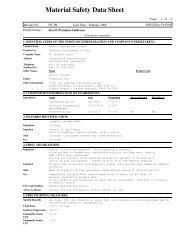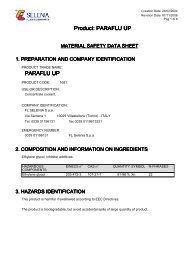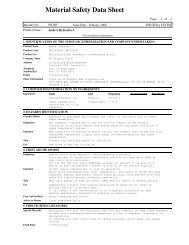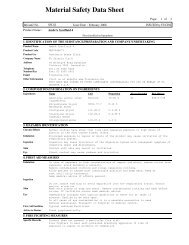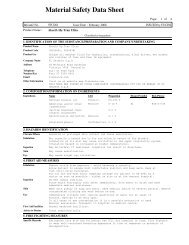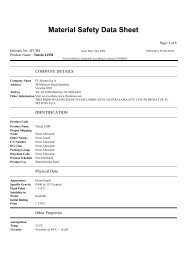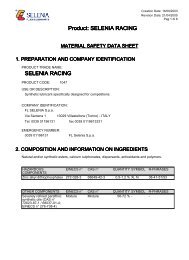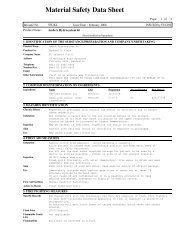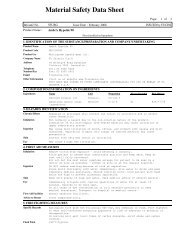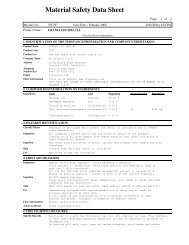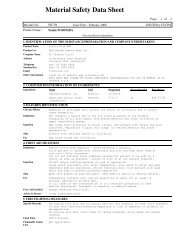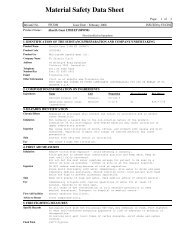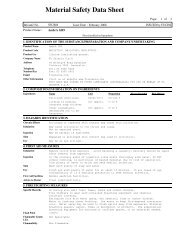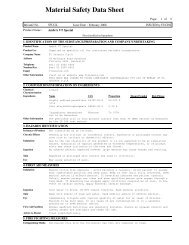G70/LS additive - FL Selenia
G70/LS additive - FL Selenia
G70/LS additive - FL Selenia
You also want an ePaper? Increase the reach of your titles
YUMPU automatically turns print PDFs into web optimized ePapers that Google loves.
Material Safety Data Sheet<br />
Page: 1 of<br />
Infosafe No. 5FUIB Issue Date : February 2008 ISSUED by FUCHS<br />
Product Name :<br />
AmbrA G7O/<strong>LS</strong> Additive<br />
Not classified as hazardous<br />
1. IDENTIFICATION OF THE SUBSTANCE/PREPARATION AND COMPANY/UNDERTAKING<br />
Product Name<br />
Product Code<br />
Company Name<br />
Address<br />
Telephone<br />
Number/Fax<br />
Email<br />
Other Information<br />
AmbrA G7O/<strong>LS</strong> Additive<br />
B96606<br />
<strong>FL</strong> <strong>Selenia</strong> S.p.A<br />
49 McIntyre Road Sunshine<br />
Victoria 3020 Australia<br />
Tel: 03 9300 6400<br />
Fax: 03 9300 6401<br />
flselenia.com<br />
Visit us at website www.flselenia.com<br />
THIS MSDS WAS ISSUED BY FUCHS LUBRICANTS (AUSTRALASIA) PTY LTD ON BEHALF OF <strong>FL</strong><br />
SELENIA S.p.A<br />
2. COMPOSITION/INFORMATION ON INGREDIENTS<br />
Ingredients<br />
Name CAS Proportion Hazard Symbol Risk Phrase<br />
Detergent/Inhibitor<br />
System Mixture<br />
Base Lubricating Oils<br />
Mixture<br />
Dye<br />
3. HAZARDS IDENTIFICATION<br />
Chronic Effects<br />
Inhalation<br />
Ingestion<br />
Skin<br />
Eye<br />
Other Information<br />
4. FIRST AID MEASURES<br />
Inhalation<br />
Ingestion<br />
Skin<br />
N/A<br />
N/A<br />
N/A<br />
55-65 %<br />
30-60 %<br />
0-1 %<br />
Repeated or prolonged skin contact can result in irritation and in severe<br />
cases dermatitis.<br />
This product has a low vapour pressure and is not expected to present an<br />
inhalation hazard at ambient conditions. Caution should be taken to prevent<br />
aerosolisation or misting of this product. The permissable exposure limit (PEL)<br />
and threshold limit value (TLV) for this product as oil mist is 5mg/m3. Exposures<br />
below 5mg/m3 appear to be without significant health risk. The short-term exposure<br />
limit for this product as an oil mist is 10mg/m3.<br />
Do not ingest. This product is relatively non-toxic by ingestion. This product has<br />
laxative properties and may result in abdominal cramps and diarrhea.<br />
Avoid skin contact. This product may cause slight skin irritation upon direct<br />
contact. Based on testing of similar products and/or components. Prolonged and<br />
repeated contact may result in contact dermatitis which is characterized by<br />
dryness, chapping, and reddening. this condition may make the skin more<br />
susceptible to othe irritants, sensitisers, and disease. Prolonged or repeated<br />
contact may result in oil acne which is characterised by blackheads with possible<br />
secondary infection.<br />
This product is practically non-irritating to the eyes upon direct contact. Based<br />
on testing of similar products and/or components.<br />
On rare occasions, prolonged and repeated exposure to oil mist poses a risk of<br />
pulmonary disease such as chronic lung inflammation. This condition is usually<br />
asymptomatic as a result of repeated small aspirations. Shortness of breath and<br />
cough are the most common symptoms.<br />
The international agency for research on cancer has concluded that highly refined<br />
mineral oils are group 3 substances, 'Not classifiable as to their carcinogenicity<br />
to humans,' based on inadequate human and inadequate animal evidence. This<br />
substance is not carcinogenic according to the OSHA hazard communication standard.<br />
This material has a low vapour pressure and is not expected to present an<br />
inhalation exposure at ambient conditions.<br />
DO NOT induce vomiting.<br />
Rinse mouth thoroughly with water immediately. Give water to drink and seek<br />
immediate medical assistance.<br />
Wash with plenty of soap and water. Seek medical advice if effects persist. Remove<br />
contaminated clothing<br />
If material is hot, submerge injured area in cold water. If victim is severely<br />
burned, remove to hospital immediately.<br />
4
Material Safety Data Sheet<br />
Page: 2 of<br />
Infosafe No. 5FUIB Issue Date : February 2008 ISSUED by FUCHS<br />
Product Name :<br />
Eye<br />
First Aid Facilities<br />
Advice to Doctor<br />
AmbrA G7O/<strong>LS</strong> Additive<br />
Not classified as hazardous<br />
Immediately irrigate with copious quantities of water for at least 15 minutes.<br />
Eyelids to be held open. If material is hot, treat for thermal burns and take<br />
victim to hospital immediately.<br />
In all cases of eye contamination it is a sensible precaution to seek medical<br />
assistance. Transport to hospital or medical centre.<br />
Normal washroom facilities.<br />
Treat symptomatically.<br />
5. FIRE FIGHTING MEASURES<br />
Extinguishing Media<br />
Specific Methods<br />
Specific Hazards<br />
Hazardous<br />
Combustion Products<br />
Flash Point<br />
Flammable Limits<br />
LEL<br />
Explosion Data<br />
Use dry chemical, foam or carbon dioxide.<br />
Water may be ineffective but can be used to cool containers exposed to heat or<br />
flame. Caution should be exercised when using water or foam as frothing may occur,<br />
especially if sprayed into containers of hot, burning liquid.<br />
Extinguish fire with the following: Use CO2, dry chemical or foam. Fire fighters<br />
to wear self-contained breathing apparatus if risk of exposure to products of<br />
decomposition.<br />
On burning will emit toxic fumes of carbon monoxide, acrid smoke and carbon<br />
dioxide.<br />
Dense smoke may be generated while burning. Carbon monoxide, carbon dioxide, and<br />
other oxides may be generated as products of combustion.<br />
177°C/typical<br />
Not applicable<br />
Not applicable<br />
6. ACCIDENTAL RELEASE MEASURES<br />
Spills & Disposal<br />
Other Information<br />
7. HANDLING AND STORAGE<br />
Additional<br />
information on<br />
precautions for use<br />
Packaging<br />
Contain - prevent contamination of drains and waterways.<br />
Use absorbent (soil or sand, sawdust, inert material, vermiculite).<br />
Collect and seal in properly labelled drums for disposal.<br />
Dispose of waste as per Local, State and Federal Land Waste Management<br />
Authorities. (Victoria:MMBW (03) 9615 6099)<br />
Notify appropriate authorities of spill. Contain spill immediately. Do not allow<br />
spill to enter sewers or watercourses. Remove all sources of ignition. Absorb with<br />
appropriate inert material such as sand, clay, etc. Large spills may be picked up<br />
using vacuum pumps, shovels, buckets, or other means and placed in drums or other<br />
suitable containers.<br />
Do not transfer to unmarked containers. Store in closed containers away from heat,<br />
sparks, open flame, or oxidising materials. Fire extinguishers should be kept<br />
readily avaliable.<br />
Observe standard safety precautions and good work practices. Do not<br />
continue to use contaminated clothing<br />
Not regulated<br />
8. EXPOSURE CONTRO<strong>LS</strong>/PERSONAL PROTECTION<br />
National Exposure<br />
Standards<br />
Respiratory<br />
Protection<br />
Eye Protection<br />
Personal Protective<br />
Equipment<br />
Body Protection<br />
Respiratory protection is not required under conditions of normal use. If vapour<br />
or mist is generated when the material is heated or handeled, use an organic<br />
vapour respirator with a dust and mist filter. All respirators must be NIOSH<br />
certified. Do not use compressed oxygen in hydrocarbon atmospheres.<br />
Eye protection is not required under conditions of normal use. If material is<br />
handled such that it could be splashed into eyes, wear plastic face shield or<br />
splash-proof safety goggles.<br />
No skin protection is required for single, short duration exposures. For prolonged<br />
or repeated exposures, use impervious clothing (boots, gloves, aprons, etc.) over<br />
parts of the body subject to exposure. If handling hot<br />
4
Material Safety Data Sheet<br />
Page: 3 of<br />
Infosafe No. 5FUIB Issue Date : February 2008 ISSUED by FUCHS<br />
Product Name :<br />
Eng. Controls<br />
Technical Protective<br />
Measures<br />
Other Information<br />
AmbrA G7O/<strong>LS</strong> Additive<br />
Not classified as hazardous<br />
material, use insulated protective clothing (boots, gloves, aprons, etc.). Launder<br />
solid clothes. Properly dispose of contaminated leather articles including shoes,<br />
which cannot be decontaminated.<br />
Maintain concentration below recommended exposure limit.<br />
If vapour or mist is generated when the material is heated or handeled, adequate<br />
ventilation in accordance with good engineering practice must be provided to<br />
maintain concentrations below the specified exposure or flammable limits.<br />
Consumption of food and beverage should be avoided in work areas where<br />
hydrocarbons are present. Always wash hands and face with soap and water before<br />
eating, drinking, or smoking.<br />
9. PHYSICAL AND CHEMICAL PROPERTIES<br />
Appearance<br />
Odour<br />
Specific Gravity<br />
(H2O=1)<br />
Volatile Component<br />
Flash Point<br />
Flammable Limits<br />
LEL<br />
Explosion Properties<br />
Other Information<br />
Blue coloured liquid.<br />
Petroleum Odour<br />
0.93<br />
None<br />
177°C/typical<br />
Not applicable<br />
Not applicable<br />
10. STABILITY AND REACTIVITY<br />
Hazardous<br />
Polymerization<br />
Materials to Avoid<br />
Hazardous<br />
Decomposition<br />
Products<br />
Hazardous Reaction<br />
Conditions to Avoid<br />
Solubility in water: Insoluble<br />
* Typical values only - Consult product information sheet.<br />
Stable<br />
Will not occur<br />
May react with strong oxidizing agents.<br />
None<br />
Store away from strong oxidizing or combustible materials.<br />
None<br />
11. TOXICOLOGICAL INFORMATION<br />
Toxicology<br />
Information<br />
Inhalation<br />
Ingestion<br />
Skin<br />
Eye<br />
Chronic Effects<br />
12. ECOLOGICAL INFORMATION<br />
No adverse haelth effects expected if this product is used in accordance<br />
with this Safety Data Sheet.<br />
This product has a low vapour pressure and is not expected to present an<br />
inhalation hazard at ambient conditions. Caution should be taken to prevent<br />
aerosolisation or misting of this product. The permissable exposure limit (PEL)<br />
and threshold limit value (TLV) for this product as oil mist is 5mg/m3. Exposures<br />
below 5mg/m3 appear to be without significant health risk. The short-term exposure<br />
limit for this product as an oil mist is 10mg/m3.<br />
Do not ingest. This product is relatively non-toxic by ingestion. This product has<br />
laxative properties and may result in abdominal cramps and diarrhea.<br />
Avoid skin contact. This product may cause slight skin irritation upon direct<br />
contact. Based on testing of similar products and/or components. Prolonged and<br />
repeated contact may result in contact dermatitis which is characterized by<br />
dryness, chapping, and reddening. this condition may make the skin more<br />
susceptible to othe irritants, sensitisers, and disease. Prolonged or repeated<br />
contact may result in oil acne which is characterised by blackheads with possible<br />
secondary infection.<br />
This product is practically non-irritating to the eyes upon direct contact. Based<br />
on testing of similar products and/or components.<br />
Repeated or prolonged skin contact can result in irritation and in severe<br />
cases dermatitis.<br />
4
Material Safety Data Sheet<br />
Page: 4 of<br />
Infosafe No. 5FUIB Issue Date : February 2008 ISSUED by FUCHS<br />
Product Name :<br />
Environ. Protection<br />
AmbrA G7O/<strong>LS</strong> Additive<br />
13. DISPOSAL CONSIDERATIONS<br />
Waste Disposal<br />
14. TRANSPORT INFORMATION<br />
Storage and<br />
Transport<br />
15. REGULATORY INFORMATION<br />
Poisons Schedule<br />
Packaging &<br />
Labelling<br />
Not classified as hazardous<br />
Non-biodegradable.<br />
Avoid contaminating waterways.<br />
* For mineral oil: Acute LC/EC50 Fish - Juvenile Rainbow Trout<br />
- Practically non-toxic. Based on testing with similar products.<br />
All disposals must comply with federal, state, and local regulations. The<br />
material, if spilled or discarded, may be a regulated waste. Refer to state and<br />
local regulations. CAUTION! If regulated solvents are used to clean up spilled<br />
material, the resulting waste mixture may be regulated. Department of<br />
transportation (DOT) regulations may apply for transporting this material when<br />
spilled. Waste material may be landfilled or incinerated at an approved facility.<br />
Materials should be recycled if possible.<br />
Store in cool place and out of direct sunlight.<br />
Protect containers against physical damage and check regularly for leaks.<br />
Do not store in open or unlabelled containers. Store away from oxidizing<br />
agents or combustible material.<br />
Not Scheduled<br />
Not regulated<br />
16. OTHER INFORMATION<br />
Contact Person/Point Laboratory Manager (03) 9300 6400<br />
Research & Development Chemist (03) 9300 6400<br />
This information was prepared in good faith from the best information available at<br />
the time of issue. It is based on the present level of research and to this extent<br />
we believe it is accurate. However, no guarantee of accuracy is made or implied<br />
and since conditions of use are beyond our control, all information relevant to<br />
usage is offered without warranty. The manufacturer will not be held responsible<br />
for any unauthorosed use of this information or for any modified or altered<br />
versions.<br />
If you are an employer it is your duty to tell your employees, and any others that<br />
may be affected, of any hazards described in this sheet and of any precautions<br />
that should be taken.<br />
Material Safety Data Sheets are updated frequently. Please ensure you have a<br />
current copy.<br />
References * NOHSC:2011 National Code of Practice for the Preparation of Material Safety Data<br />
Sheets<br />
* NOHSC:1008 Approved Criteria for Classifying Hazardous Substances<br />
* NOHSC:10005 List of Designated Hazardous Substances<br />
* NOHSC:1005 Control of Workplace Hazardous Substances, National Model Regulations<br />
* NOHSC:2007 Control of Workplace Hazardous Substances, National Code of Practice<br />
* NOHSC:1003 Exposure Standards for Atmospheric Contaminants in the Occupational<br />
Environment, National Exposure Standards<br />
* NOHSC:3008 Exposure Standards for Atmospheric Contaminants in the Occupational<br />
Environment, Guidance Note<br />
* NOHSC:1015 Storage and Handling of Workplace Dangerous Goods, National Standard<br />
* NOHSC:2017 Storage and Handling of Workplace Dangerous Goods, National Code of<br />
Practice<br />
* SUSDP, Standard for the Uniform Scheduling of Drugs and Poisons<br />
* ADG, Australian Dangerous Goods Code<br />
* MSDS of component materials<br />
4<br />
Last Change Issue date: 23/11/04<br />
Reason/s for change: Name changed.<br />
Poisons Schedule Not Scheduled<br />
...End Of MSDS...



